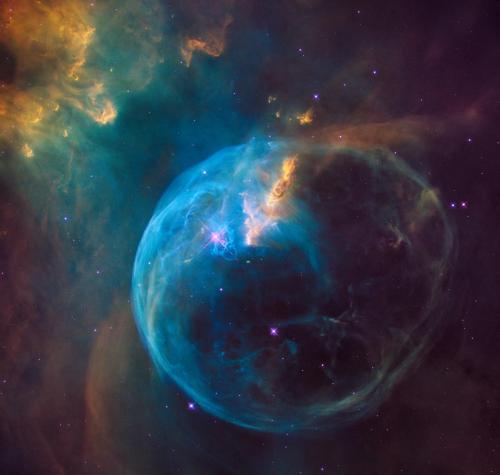Your personal Tumblr journey starts here
Hubble Space Telescope - Blog Posts
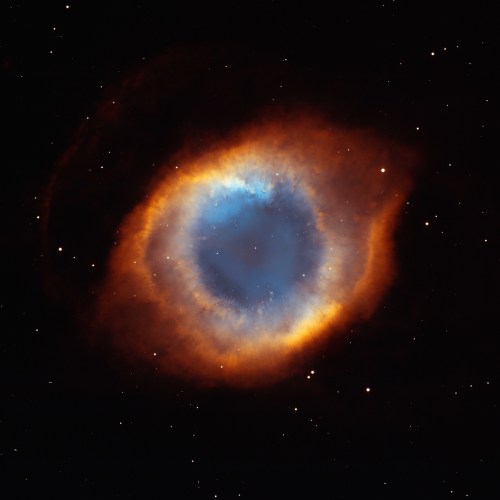
Say hello to the Helix Nebula 👋
In 2001 and 2002, our Hubble Space Telescope looked at the Helix Nebula and it looked right back! This planetary nebula is right in our cosmic neighborhood, only about 650 light-years away. Gigantic for this type of cosmic object, the Helix Nebula stretches across 2 to 3 light-years.
With no actual connection to planets, planetary nebulas like this one are produced when a medium-mass star dies and sloughs off its outer layers. These gaseous layers are expelled into space at astonishing speeds where they light up like fireworks. The Helix Nebula is one of the closest planetary nebulas to Earth, giving scientists an up-close view of its strange affairs.
Through Hubble’s observations, scientists have learned that the Helix Nebula isn’t doughnut-shaped as it appears. Instead it consists of two disks that are nearly perpendicular to each other — the nebula looks like an eye and bulges out like one too!
Hubble has also imaged comet-like tendrils that form a pattern around the central star like the spokes on a wagon wheel, likely resulting from a collision between gases. The dying star spews hot gas from its surface, which crashes into the cooler gas that it ejected 10,000 years before. Eventually the knots will dissipate into the cold blackness of interstellar space.
Make sure to follow us on Tumblr for your regular dose of space: http://nasa.tumblr.com.


#InternationalCatDay? Try #IntergalacticCatDay.
Check out features of our feline friends that have come to life as interstellar phenomena!
Pictured first, the Cat’s Paw Nebula is located about 4,200-5,500 light-years from Earth – situated in our very own Milky Way Galaxy. It was named for the large, round features that create the impression of a feline footprint and was captured by our Spitzer Space Telescope. After gas and dust inside the nebula collapse to form stars, the stars may in turn heat up the pressurized gas surrounding them. This process causes the gas to expand into space and form the bright red bubbles you see. The green areas show places where radiation from hot stars collided with large molecules called "polycyclic aromatic hydrocarbons," causing them to fluoresce.
Next, you’ll find the Cat’s Eye Nebula. Residing 3,000 light-years from Earth, the Cat’s Eye represents a brief, yet glorious, phase in the life of a sun-like star. This nebula's dying central star may have produced the simple, outer pattern of dusty concentric shells by shrugging off outer layers in a series of regular convulsions. To create this view, Hubble Space Telescope archival image data have been reprocessed. Compared to well-known Hubble pictures, the alternative processing strives to sharpen and improve the visibility of details in light and dark areas of the nebula and also applies a more complex color palette. Gazing into the Cat's Eye, astronomers may well be seeing the fate of our sun, destined to enter its own planetary nebula phase of evolution ... in about 5 billion years.
Make sure to follow us on Tumblr for your regular dose of space: http://nasa.tumblr.com.

Say hello to the Jewel Box Cluster 👋
This Hubble Space Telescope image shows a young, open star cluster known as NGC 4755 or the Jewel Box. Just like old school friends that drift apart after graduation, the stars in open clusters only remain together for a limited time. They disperse into space over the course of a few hundred million years, pulled away by the gravitational tugs of other passing clusters and clouds of gas.
The Jewel Box is a spartan collection of just over 100 stars. The cluster is about 6,500 light-years away from Earth, which means that the light we see from it today was emitted before the Great Pyramids in Egypt were built.
Head outside and you can see it for yourself! The Jewel Box is visible to the naked eye, but will masquerade as a single star. Grab a pair of binoculars if you want to see more of the cluster’s sparkling stellar population. It is located in the southern constellation of the cross (Crux).
Make sure to follow us on Tumblr for your regular dose of space: http://nasa.tumblr.com.

Say hello to the Carina Nebula 👋
One of the largest panoramic images ever taken with our Hubble Space Telescope’s cameras, this image features a stunning 50-light-year-wide view of the intense central region of the Carina Nebula - a strange stellar nursery. The nebula is sculpted by the action of outflowing winds and scorching ultraviolet radiation from the monster stars that inhabit this inferno. The Carina Nebula lies within our own galaxy, about 7,500 light-years away.
At the heart of the nebula is Eta Carinae — a system of two stars. The larger star, Eta Car A, is around 100 times as massive as the Sun and 5 million times as luminous! Stars of this size are extremely rare; our galaxy is home to hundreds of billions of stars, but only tens of them are as massive as Eta Car A.
This view of the Carina Nebula provided astronomers the opportunity to explore the process of star birth at a new level of detail. The hurricane-strength blast of stellar winds and blistering ultraviolet radiation within the cavity are now compressing the surrounding walls of cold hydrogen. This is triggering a second stage of new star formation. Hubble has also enabled scientists to generate 3-D models that reveal never-before-seen features of the interactions between the Eta Carinae star system.
Make sure to follow us on Tumblr for your regular dose of space: http://nasa.tumblr.com.

Say hello to globular cluster 47 Tucanae 👋
This glittery spray of ancient stars is about 16,700 light-years away from Earth toward the constellation Tucana. Globular clusters like this one are isolated star cities, home to hundreds of thousands of stars that are held together by their mutual gravity. And like the fast pace of cities, there's plenty of action in these stellar metropolises. The stars are in constant motion, orbiting around the cluster's center.
Past observations have shown that the heavyweight stars tend to crowd into the “downtown” core area, while lightweight stars reside in the less populated suburbs. But as heavyweight stars age, they rapidly lose mass, cool down and shut off their nuclear furnaces. After the purge, only the stars' bright, superhot cores – called white dwarfs – remain. This weight loss program causes the now lighter-weight white dwarfs to be nudged out of the downtown area through gravitational interactions with heftier stars.
Until these Hubble observations, astronomers had never seen the dynamic conveyor belt in action. The Hubble results reveal young white dwarfs amid their leisurely 40-million-year exodus from the bustling center of the cluster.
Make sure to follow us on Tumblr for your regular dose of space: http://nasa.tumblr.com.
Strap in for a Tour of the Milky Way

The night sky isn’t flat. If you traveled deep into this part of the sky at the speed of the radio waves leaving this tower, here are some places you could reach.
Jupiter: Travel time – 35 minutes, 49 seconds.

The closest object in this view is the planet Jupiter, brilliant now in the evening sky…and gorgeous when seen up close by our Juno spacecraft. Distance on the night this picture was taken: 400 million miles (644 million kilometers).
Saturn: Travel time – one hour and 15 minutes.

The next closest is Saturn, another bright “star” in this summer’s sky. On the right, one of the Cassini spacecraft’s last looks. Distance: 843 million miles (1.3 billion kilometers).
Pluto: Light-speed travel time from the radio tower – four hours, 33 minutes.

It’s not visible to the unaided eye, but Pluto is currently found roughly in this direction. Our New Horizons space mission was the first to show us what it looks like. Distance: more than 3 billion miles.
F-type star, HD 169830: Light-speed travel time from the radio tower – 123 years.

Within this patch of sky, there’s an F-type star called HD 169830. At this speed, it would take you 123 years to get there. We now know it has at least two planets (one of which is imagined here) — just two of more than 4,000 we've found…so far.
The Lagoon Nebula: Light-speed travel time from the radio tower – 4,000 years.

If you look closely, you’ll see a fuzzy patch of light and color here. If you look *really* closely, as our Hubble Space Telescope did, you’ll see the Lagoon Nebula, churning with stellar winds from newborn stars.
Black hole, Sagittarius A*: Light-speed travel time from the radio tower – 26,000 years.

In 26,000 years, after passing millions of stars, you could reach the center of our galaxy. Hidden there behind clouds of dust is a massive black hole. It’s hidden, that is, unless you use our Chandra X-ray Observatory which captured the x-ray flare seen here.

The next time you’re under a deep, dark sky, don’t forget to look up…and wonder what else might be out there.
Make sure to follow us on Tumblr for your regular dose of space: http://nasa.tumblr.com.

Say hello to the Eskimo Nebula 👋
This nebula began forming about 10,000 years ago when a dying star started flinging material into space. When Sun-like stars exhaust their nuclear fuel, they become unstable and blast their outer layers of gas away into space (bad news for any planets in the area). This Hubble Space Telescope image shows a snapshot of the unworldly process.
Streams of high-energy ultraviolet radiation cause the expelled material to glow, creating a beautiful planetary nebula — a term chosen for the similarity in appearance to the round disk of a planet when viewed through a small telescope.
The Eskimo Nebula got its nickname because it resembles a face surrounded by a fur parka. The “parka” is a disk of material embellished by a ring of comet-shaped objects with their tails streaming away from the central, dying star. In the middle of the nebula is a bubble of material that is being blown outward by the star’s intense “wind” of high-speed material.
Make sure to follow us on Tumblr for your regular dose of space: http://nasa.tumblr.com.
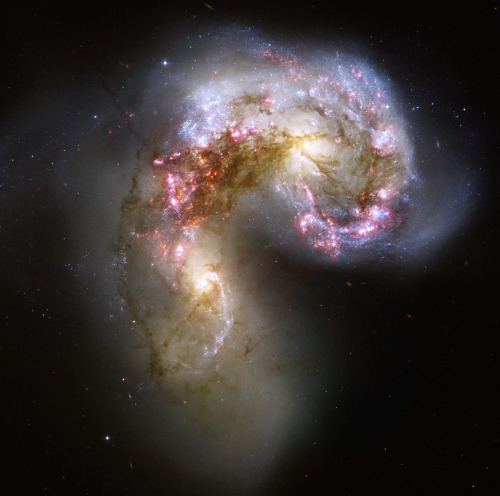
Say hello to the Antennae galaxies 👋
Two galaxies are locked in a deadly embrace in this Hubble Space Telescope image. Once normal, sedate spiral galaxies like the Milky Way, this galactic pair has spent the past few hundred million years sparring. The clash is so violent that stars have been ripped from their host galaxies to form a streaming arc between the two.
The far-flung stars and streamers of gas stretch out into space, creating long tidal tails reminiscent of antennae (not visible in this close-up Hubble view). Clouds of gas blossom out in bright pink and red, surrounding the bright flashes of blue star-forming regions — some of which are partially obscured by dark patches of dust.
Hubble’s observations have uncovered over 1,000 bright, young star clusters bursting to life as a result of the head-on wreck. The sweeping spiral-like patterns, traced by bright blue star clusters, shows the result of a firestorm of star-birth activity, which was triggered by the collision. The rate of star formation is so high that the Antennae galaxies are said to be in a state of starburst, a period in which all of the gas within the galaxies is being used to form stars. This cannot last forever, and neither can the separate galaxies; eventually the nuclei will coalesce and the galaxies will begin their retirement together as one large elliptical galaxy.
Make sure to follow us on Tumblr for your regular dose of space: http://nasa.tumblr.com.
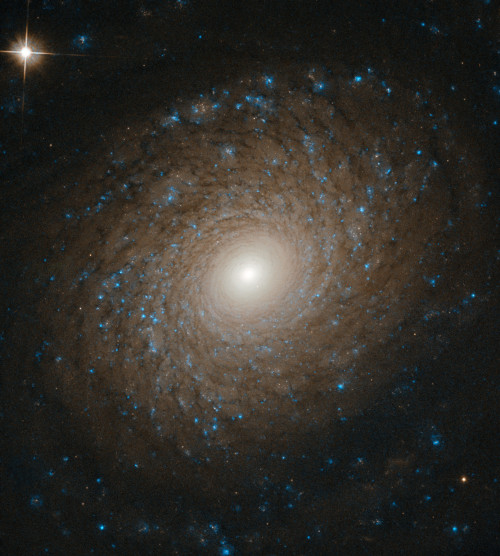
Flawless. Gorgeous. Stellar.
You probably think this post is about you. Well, it could be.
In this image taken by our Hubble Space Telescope, we see a spiral galaxy with arms that widen as they whirl outward from its bright core, slowly fading into the emptiness of space. Click here to learn more about this beautiful galaxy that resides 70 million light-years away.
Credit: ESA/Hubble & NASA, L. Ho Make sure to follow us on Tumblr for your regular dose of space: http://nasa.tumblr.com.

Pew! Pew! Pew!
Imagine slow-motion fireworks that started exploding 170 years ago and are still continuing. This type of firework is not launched into Earth's atmosphere, but rather into space by a doomed super-massive star, called Eta Carinae.
Enjoy the the latest view from our Hubble Space Telescope.
Make sure to follow us on Tumblr for your regular dose of space: http://nasa.tumblr.com.
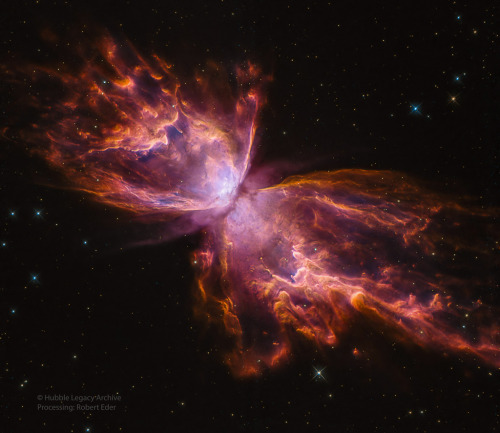
DYK the bright clusters and nebulae of planet Earth's night sky are often named for flowers or insects?
Though its wingspan covers over 3 light-years, NGC 6302: The Butterfly Nebula is no exception! With an estimated surface temperature of about 250,000 degrees C, the dying central star of this particular planetary nebula has become exceptionally hot, shining brightly in ultraviolet light but hidden from direct view by a dense torus of dust. This sharp close-up was recorded by the Hubble Space Telescope in 2009. The Hubble image data is reprocessed here, showing off the remarkable details of the complex planetary nebula.
Image Credit: NASA, ESA, Hubble, HLA; Reprocessing & Copyright: Robert Eder
Make sure to follow us on Tumblr for your regular dose of space: http://nasa.tumblr.com.

Spectacular death. Spectacular star. Your crushed heart remains bright from afar. You’re looking at a composite image of the Crab Nebula, located 6,500 light-years away. The white dot in the center — an extremely dense ball of neutrons just 12 miles across but with the same mass as our Sun — is all that remains from a star that exploded in 1054 A.D. Had the blast occurred 50 light-years away, its intense radiation would have wiped out most life forms on Earth. Spectacular death. Spectacular star. We’re grateful we can admire you from afar.
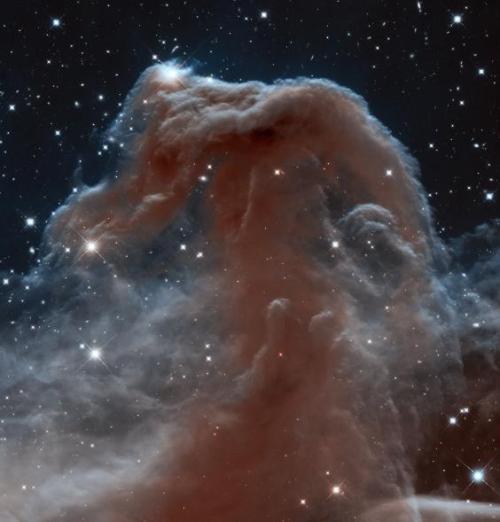
Known as the Horsehead Nebula – but you can call it Starbiscuit.
Found by our Hubble Space Telescope, this beauty is part of a much larger complex in the constellation Orion.
Make sure to follow us on Tumblr for your regular dose of space: http://nasa.tumblr.com.
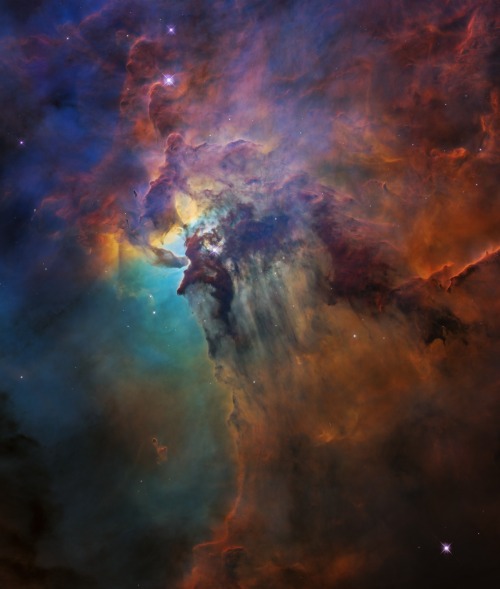
The Lagoon Nebula
This colorful image, taken by our Hubble Space Telescope between Feb. 12 and Feb. 18, 2018 , celebrated the Earth-orbiting observatory’s 28th anniversary of viewing the heavens, giving us a window seat to the universe’s extraordinary tapestry of stellar birth and destruction.
At the center of the photo, a monster young star 200,000 times brighter than our Sun is blasting powerful ultraviolet radiation and hurricane-like stellar winds, carving out a fantasy landscape of ridges, cavities, and mountains of gas and dust.
This region epitomizes a typical, raucous stellar nursery full of birth and destruction. The clouds may look majestic and peaceful, but they are in a constant state of flux from the star’s torrent of searing radiation and high-speed particles from stellar winds. As the monster star throws off its natal cocoon of material with its powerful energy, it is suppressing star formation around it.
Make sure to follow us on Tumblr for your regular dose of space: http://nasa.tumblr.com.
